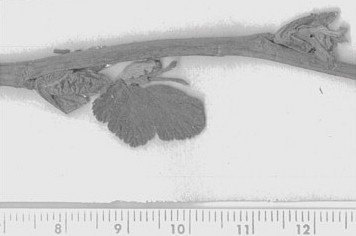| Botanical Discoveries:
Red-flowering Currant (Ribes sanguineum)
Cowlitz River in Oregon, March
27, 1806
Captain Lewis collected this
specimen on March 27, 1806. That day the expedition
stopped near Rainier and near Globe, both in Columbia
County, Oregon. The specimen shown, upper right, may
have come from either place. We imagine Lewis was
attracted to the plant because of it's wonderful color.
He probably foresaw landscape uses as it is quite
attractive.
Uses: Red-flowering currant is a
drought tolerant deciduous shrub that may be useful in
restoration plantings. It provides early spring nectar
for hummingbirds and butterflies, forage for the larvae
of more than two dozen species of moths and butterflies,
and nesting sites or cover for songbirds and small
mammals. Numerous birds including grouse, quail, robins,
finches, towhees, and woodpeckers, and small mammals
consume the berries.
Management: Provide supplemental
water during the first and perhaps second season but
allow soil to dry 3-4 in. down between irrigations and
do not provide water after mid to late summer when
leaves naturally begin to fall. Prune immediately after
flowering to encourage vigorous growth suitable for
future flower bearing. |
 |
 |
|
|
The Expedition's Journey
Continues: The journey home has begun. The party is fresh from
their overwinter stay at Fort Clatsop and eager to be on the trail.
"We had a view of Mount St. Helens and
Mount Hood. The first is the most noble-looking object of its kind in
nature. Its figure is a regular cone. Both these mountains are perfectly
covered with snow -- at least the parts of them which are visible. The
highlands in this valley are rolling, though by no means too steep for
cultivation. They are generally fertile, of a dark rich loam and
tolerably free of stone."
Captain Lewis, 30 March 1806
The Expedition had barely begun the return trip
when they met with several members of the Shahala nation who told the
party of a large river that had been missed in their travels. Captain
Clark says:
"We readily prevailed on them to give
us a sketch of this river, which they drew on a mat with a coal. It
appeared that this river, which they call Multnomah, discharged itself
behind the island we call the Image Canoe Island, and as we had left
this island to the south in descending and ascending the river we had
never seen it. They informed us that it was a large river, and runs a
considerable distance to the south between the mountains."
At this information, Captain Clark took a side
trip in search of this river. Not one to pass up an opportunity to procure
supplies, he tried to trade for some wappato (elk meat). He says the
natives were "sulky and they positively refused to sell any."
Captain Clark deigned to take this refusal as the final word and set about
changing their minds.
"I had a small piece of port fire match
in my pocket, off of which I cut a piece one inch in length and put it
into the fire, and took out my pocket compass and sat myself down on a
mat on one side of the fire, and also showed a magnet, which was in the
top of my inkstand. The port fire caught and burned vehemently, which
changed the color of the fire. With the magnet I turned the needle of
the compass about very briskly, which astonished and alarmed these
natives, and they laid several parcels of wappato at my feet, and begged
of me to take out the bad fire. To this I consented. At this moment, the
match being exhausted was of course extinguished, and I put up the
magnet, etc. This measure alarmed them so much that the women and
children took shelter in their beds, and behind the men. All this time,
a very old blind man was speaking with great vehemence, apparently
imploring his god."
And so by his bold action and keeping his eye on
the prize, Captain Clark brought back to the Corps some fresh meat and
documentation of another river, both greatly prized.
Next week we look again at the interaction
between the Expedition and the peoples and lands they found on their way
home.
Go to our Corps of Discovery Expedition
Bicentennial Index page
to see all links in this series. Or click
here
to go directly to the next installment of our
journey.
|
 |
|
Bringing history alive:
World
Premiere:
Show-Me Opera of the University of Missouri-Columbia presented
the world premiere of Corps of
Discovery, A Musical Journey
This
commemorative opera played on May 2, 3 and 4, 2003.
The three-act musical drama is an artistic interpretation, 200 years
later, of the significance of Lewis and Clark’s expedition.
The Kennedy Center
website has an excellent write-up of this event showing the
cast, synopsis of the acts and short bio of the creating
team. Also available is a link to watch past performances.
Go to
www.kennedy-center.org/explorer/artists/?entity_id=10026&source_type=B |
 |
Another website, that of Eric
Thomas Dillner (www.ericdillner.com/corps-of-discovery-a-musical-journey-of-the-lewis-and-clark-expedition.html),
discusses the project from his
viewpoint: Mr. Dillner created the
project concept for the University
of Missouri – Columbia to commission
a new mainstage opera based on the
Lewis and Clark Expedition in
celebration of the journey’s
Bicentennial.
As project leader, Mr. Dillner
commissioned composer, Michael Ching
and librettist, Hugh Moffatt
(librettist) to produce the new
work. As co-grant writer, Mr.
Dillner raised $80,000 for the
initial stages of project.
Following workshops at Ashlawn-Highland
Summer Festival, York Theatre (New
York City Off Broadway), Kennedy
Center, Washington, D.C., and Opera
Festival of New Jersey, the World
Premiere was produced by Opera
Memphis and the College Premiere was
produced by University of
Missouri-Columbia. Numerous
additional productions have had
great success throughout the US.
|
|